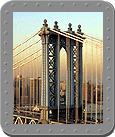|
|||||||

|
| The Manhattan Bridge is a suspension bridge. The overhead cables support its roadway. |
![]()
Bridges illustrate the effect of weight or another force at a distance
from a pivot or support point (torque), and they also provide experience
with beams.
In this activity, students experiment with a variety of shapes such as
folded corrugations and rolled tubes that can make an inherently weak
material such as paper much stronger. Paper is very weak under compression
and is somewhat stronger under tension (i.e., it collapses when you push
the ends together but it doesn't pull apart easily). When you put weight
on a sheet of paper it tends to buckle because it is very thin. It has
no strength along the thin direction. By folding or rolling the paper,
you create a "thickness" which allows the paper to reinforce itself and
not collapse so easily.
You can illustrate this property of paper in a simple demonstration with
an 8-foot-long 2-by-4 piece of lumber. Support the beam on two short blocks
at either end. Lay the beam flat and push down at the center. It gives
easily. Now, turn the beam on its side (have helpers steady each end on
the blocks for stability). In this case, when you push down at the center,
the beam is much more rigid. When turned on its side, there is more wood
further from the center line, in
the areas where it can best counteract the tension on the top and compression
on the bottom.
There
is a diagram demonstrating this activity on the next page.

